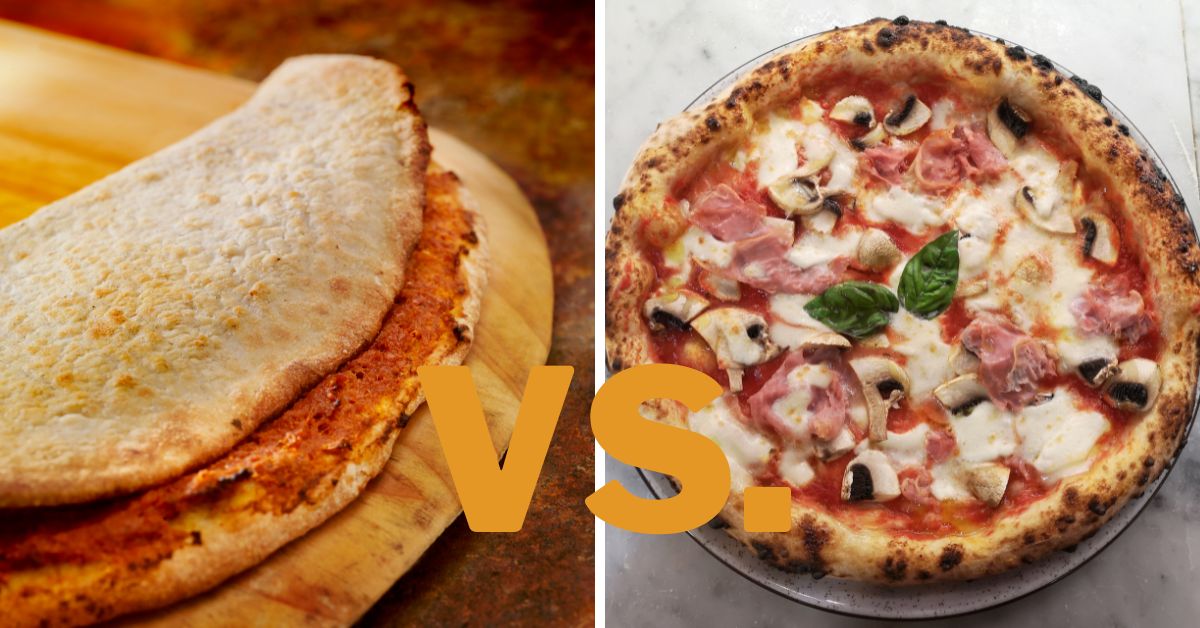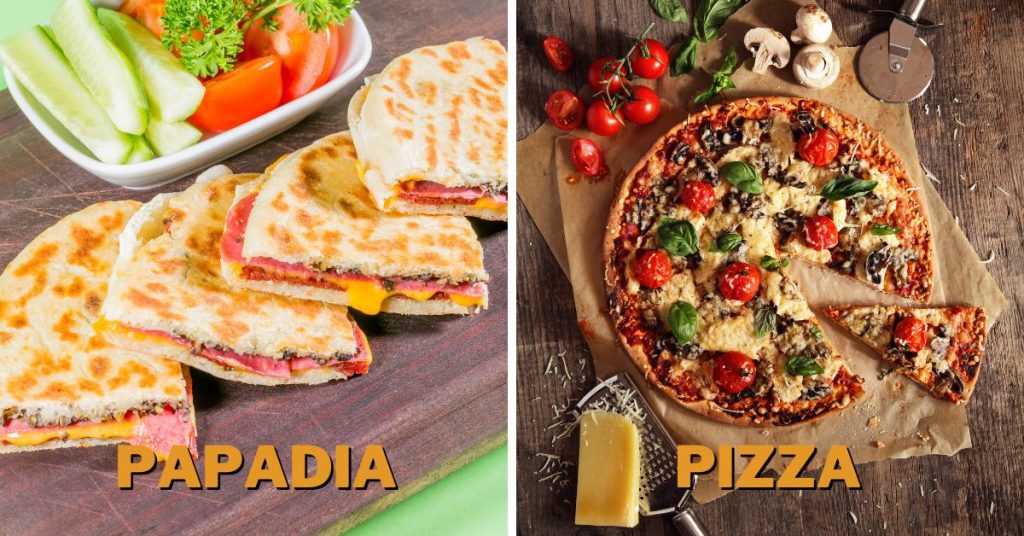Papadia vs. Pizza: Differences & Which Is Better?

Many regard Papadia and pizza as the same thing. Even though you won’t be entirely wrong to find them similar, you would be wrong to call them the same. So, what are the differences between Papadia and pizza, and which is better?
Pizza is a dough topped with different toppings, the most common being tomato sauce and cheese. The dough is topped and baked. Papadia is a flatbread sandwich made with Alfredo sauce, Italian sausage, salami, mozzarella, and banana peppers.
Pizza and Papadia are very similar but not the same; therefore, it would be a shame not to know what makes them unique. In the following paragraphs, I will describe Papadia and pizza in detail and explain the aspects in which they differ.
Papadia vs. Pizza: Differences
Before we start, here’s a cheat sheet to help you out.
| Papadia | Pizza | |
|---|---|---|
| Taste | Traditionally strong and spicy | Traditionally milder than Papadia, but still flavorful |
| Filling | Traditionally filled with Alfredo sauce, Italian sausage, salami, mozzarella, and banana peppers. | Traditionally topped with mozzarella and tomato sauce. |
| Making | Made with Italian flatbread, folded and baked | Traditionally made with flatbread, topped, and baked.. |
| Nutrition | High in carbohydrates and calories. It contains protein, and the meat makes it fatty. | High in carbohydrates and calories. It contains protein, and the meat makes it fatty. |
| Popularity | Popular worldwide, but mainly in Europe and the USA. | Popular worldwide, but mainly in Europe and the USA. |
| Appearance and sizes | Similar in size to pizza, but triangle-shaped and more robust. | Round-shaped, larger than Papadia. More tender than Papadia. |
| Serving and side dishes | It is traditionally served with pepperoncini and a sauce of choice on the side. | It is traditionally served with tomato sauce. |
| Origin | 2019, USA, Papa John’s brand | 16th century- Naples, Italy |
The most significant difference between Papadia and pizza is the shape and the filling/topping. Papadia is a flatbread pizza sandwich, while pizza is topped and baked dough.
Both pizza and Papadia are baked and have many variations. However, pizza is more popular and widely available, while Papadia is primarily Papa John’s signature food item.
Preparation, Filing, and Dough
Papadia and pizza are very similar to make. Both made of flatbread dough, pizza and Papadia are both baked, with the pizza topping that Papadia is filled.
Now, Papadia is technically also topped, but it is then made into a sandwich, and therefore the topping is filling.
The Papadia filling is traditionally made with Alfredo sauce, Italian sausage, salami, mozzarella, and banana peppers. On the other hand, pizza is traditionally topped with tomato sauce and cheese.
Both are foods that often need a quick bite on the go.
Therefore, to accommodate everyone’s taste and preference, there are many variations regarding the filling/topping of pizza and Papadia. What you put on your pizza or in your Papadia is essentially up to you and what you prefer. There are millions of pizza toppings, from vegetarian to heavily meaty and cheesy.
Papa also comes in different variations. For example, there’s a barbeque version of Papadia, chicken, meatballs, pepperoni, bacon, and cheesesteak.
Therefore, the filling/topping ideas are countless and very susceptible to creativity and imagination.
Taste
Papadia and pizza have as many tastes as there are fillings/toppings. Therefore we are about to compare the traditional pizza topping and the traditional Papadia filling.
Containing Alfredo sauce, Italian sausage, salami, mozzarella, and banana peppers, Papadia tastes stronger and more intense than a pizza. Compared to pizza, Papadia is spicier and more robust.
Pizza, on the other hand, is milder-tasting than Papadia; again, if we are talking about the traditional pizza topping. Pizza is the perfect balance between tomato and cheese, which is one of the best combinations.
When it comes to the variations of pizza and Papadia, we can discuss a range of tastes, from cheesy and meaty to vegetarian and light.
However, given that the options are so many, I can say that comparing the taste of Papadia and pizza in any aspect other than their traditional tastes would be futile.
Appearance and Size
Papadia has a triangular shape, while pizza has a round shape. In terms of size, traditionally, pizza is larger than Papadia, which is to be expected since Papadia is basically folded pizza.
However, if we compared pizza and unfolded Papadia, their sizes would probably be nearly identical. Still, pizza comes in several sizes, small, medium, large, and family, and the size of an unfolded Papadia would be around the size of a medium-sized pizza.
In addition, since Papadia is folded, it is rougher than a pizza. When you bite the pizza, you bite the toppings. Therefore your palate touches a smoother and softer surface.
On the other hand, when you bite into the Papadia, your palate touches dry dough before you reach the filling.

Variations
As I already mentioned, Papadia and pizza are available in many variations, whit the flavor depending only on what you fill/top them with. Since the ingredients are left entirely to your imagination, the variations are endless.
Papadia has main variations: Italian, BBQ Chicken & Bacon, Philly Cheesesteak, and Meatball & Pepperoni. Still, other flavors are always an option if you’re feeling creative.
However, Papadia still hasn’t officially seen its vegetarian version, but there’s no reason not to experiment on your own.
The important thing for both Papadia and pizza is the dough and making. If you make them with unleavened pizza dough and bake them properly, you can top your pizza or fill your Papadia with whatever you want.
Popularity and Origin
Papadia was created in 2019 by the Papa Jones brand, so pretty new. It is a fusion between piadina and pizza, and it was inspired by the piadina- an Italian folded flatbread sandwich originating in Northern Italy.
Pizza, on the other hand, has a very long history. The concept of flatbread with toppings originates from the ancient Greek, Roman, and Egyptian cultures. The recipe had evolved differently in each of these cultures and spawned other pastry delights.
Pizza, as we now know it, originates in Naples-Italy. It was invented as people’s food, which is why it was and still is so widely available.
Papadia and pizza are both very popular in the USA, especially since they had already become famous long before the birth of Papadia. Since they are so customizable, variations of pizza and Papadia have been rooted in various cultures so profoundly that today, even the dough is different in some of them.
Serving and Side Dishes
Even though pizza and Papadia are perfectly ok to have on the go, in fact, they were invented for the fast-paced people needing a quick meal; you can turn them into a fine dining experience nevertheless.
Pizza is traditionally served with some extra tomato sauce on the side, and Papadia is served with pepperoncini and a sauce of choice on the side. However, how your Papadia or pizza are mainly served depends on how the restaurant wants to present them.
Therefore, you can find a fancy pizza or Papadia plate, as well as casually served, with nothing more than the bare essentials.
Both pizza and Papadia go excellent with fresh green salads, olives, mozzarella sticks, grilled mushrooms, and sauces, depending on the pizza topping/Papadia filling.
Nutrition
Pizza and Papadia are very similar in nutritional value. [1] [2] They both contain quite a bit of carb, and depending on what else they contain, they can vary in terms of protein, fat, and calorie amount but still are on the higher end.
Since the nutritional value of Papadia and pizza is dependent on what else they contain, it is hard to compare them, as there are meaty and cheesy, as well as light versions of both pizza and Papadia.
The constant, however, is the dough and, with it, the carbs. Also, cheese is another thing both pizza and Papadia contain consistently in nearly all variations. We can add protein and fat from the cheese as a constant to the nutritional value of these pastries.
Papadia vs. Pizza: Which Is Better?
It would be neither fair nor accurate to say that one is better than the other. Pizza and papadia have advantages and can satisfy even the most discriminating tastes.
Papadia is generally rougher and more robust than pizza, while pizza is milder and gentler than Papadia.
Papadia is mainly intended to have on the go, while pizza can be enjoyed in a more elegant setting. Pizza and Papadia have countless variations, appeal to a large audience, and are highly customizable according to your taste and mood.
Is Papadia a Calzone?
Papadia is not a calzone. While Papadia is stronger and spicier than calzone, calzone is milder than Papadia. Papadia combines a pizza and a sandwich, while calzone is a traditional hot pocket.
Papadia is folded into a triangular shape, while calzone is folded and sealed. Both calzone’s and Papadia’s fillings are highly customizable.
The traditional calzone filling contains mozzarella, pecorino, or parmesan combined with salami or ham, or vegetables, and an egg. Papadia is traditionally made with Alfredo sauce, Italian sausage, salami, mozzarella, and banana peppers.
How Big Is Papadia?
Papadia is very similar in size to a medium-sized pizza. Of course, pizza is larger than Papadia since it isn’t folded. However, Papadia is generally the same size as an unfolded medium-sized pizza.
Because pizza is flat and Papadia is folded, Papadia looks plumper than a pizza.
Is Papadia Any Good?
Not only is Papadia good, but it is amazing. The taste is rich and strong, but the texture is pretty robust. Still, the symphony of flavors will make up for any rough exterior you may encounter on your Papadia.
Moreover, as customizable as it is in terms of flavors and fillings, you are bound to find your Papadia groove, and if it doesn’t exist, well, you can just create it.
What Does Papadia Mean?
The word “Papadia” means “the father of the pope.” It has a Latin origin.
